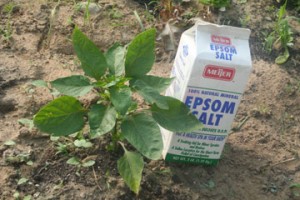Peppers, Tomatoes, and Epsom Salts
 Question from Barbara:
Question from Barbara:
I saw you at the San Diego Horticultural Society meeting and I’m a bit confused. Can you explain why one should spray pepper plants with Epson Salts? What does it do? And, what are the proportions? I can’t remember for the life of me!
Answer from Pat:
No problem! It’s difficult to remember everything. Spraying the leaves of pepper plants with 1 teaspoon Epsom salts mixed into about a pint or so of lukewarm water gives the plants extra magnesium. (I use a small, hand-held household sprayer.) This produces dark green leaves and a bigger and better harvest. The right time to spray the plants is when the flowers first show. You don’t need to do it more than once, but twice at intervals at one or two weeks is okay too. Spray the foliage and the plants absorb the magnesium through their leaves. See page 279 of my book for more details.


Is this good for tomato plants also? My tomato leaves have brown spots on them, why?
Spraying the leaves of tomato plants with a solution of Epsom salts adds magnesium to the plant. It can help to green-up leaves and may contribute to all-over plant vigor. But Epsom salts will have no effect on diseases afflicting tomatoes. Tomatoes are subject to a number of diseases and whereas these diseases seldom kill the plants they can effect their appearance and also reduce or spoil the harvest. Unfortunately, moist rainy weather makes disease problems worse.
Several of the diseases afflicting tomatoes cause spots on leaves. Early Blight cab affect the foliage, stems, and fruit of tomatoes. Symptoms include dark spots with concentric rings around them that occur on older leaves first. Late Blight affects the foliage, stems, and fruit of tomatoes and spots on leaves are greasy irregularly shaped and gray with sometimes a ring of gray mold around that. Septoria Leaf Spot is sometimes mistaken for Late Blight. Papery patches on leaves develop tiny dark spots within them. Older leaves get the problem first. Gray leaf spot is another disease again affecting oldest leaves first, but it affects plants in Texas more than in California.
With all these diseases, the first attack should be to clean up the plant. Get rid of all debris and dead leaves. Keep a clean garden. Late Blight is a serious disease that caused the 19th century potato famine. The solution is to keep a clean garden, rotate crops, and destroy affected plants. Don’t save your own seed potatoes since this can spread the disease.
Serenade™ is a registered product, a biological fungicide that can be safely used by organic gardeners. in some cases spraying with Serenade can control or may even cure the problem. With Late Blight it can only prevent it.